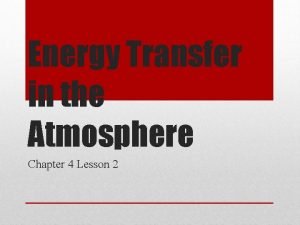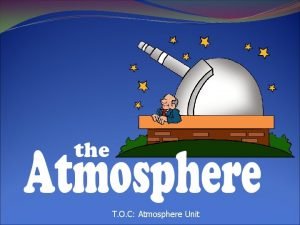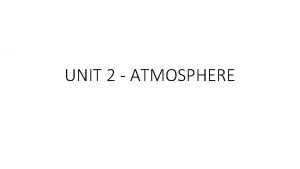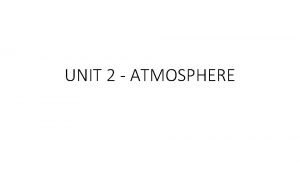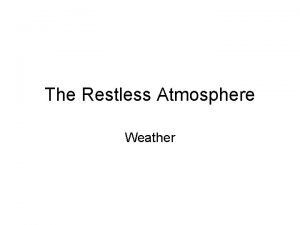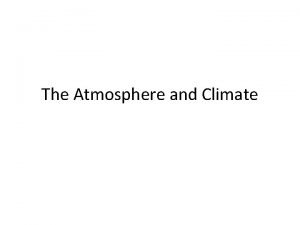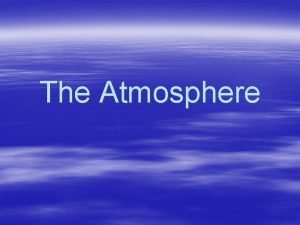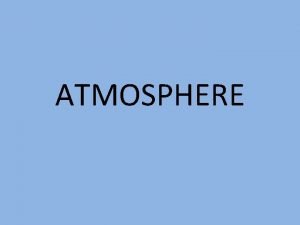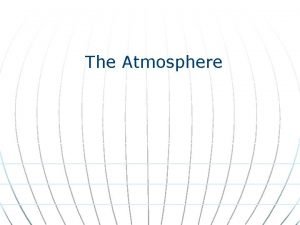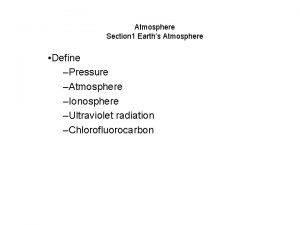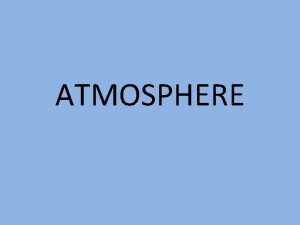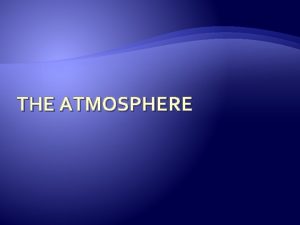Unit 3 Lesson 1 The Atmosphere What is















- Slides: 15

Unit 3 Lesson 1 The Atmosphere What is Earth’s atmosphere? • The atmosphere is the mixture of gases that surrounds Earth. • Functions of the atmosphere: • Protects organisms from the sun’s damaging UV rays • Maintains the right temperature range for life. • Supplies gases necessary for breathing. Copyright © Houghton Mifflin Harcourt Publishing Company

Unit 3 Lesson 1 The Atmosphere What is Earth’s atmosphere? • Properties of the atmosphere: • Density: The mass of gas in a given volume of air. It depends on the number of molecules present and types of molecules. • Pressure: The amount of force exerted to a surface by the weight of air. • Temperature: The measure of hotness or coldness of an object. Copyright © Houghton Mifflin Harcourt Publishing Company

Unit 3 Lesson 1 The Atmosphere Composition: Gas components: • 78 percent nitrogen gas, • 21 percent oxygen gas • 1 percent other gases. Solid components: • small particles of dust, volcanic ash, sea salt, smoke, skin, bacteria, and pollen. Water: • Clouds: Liquid water and solid in the form of ice and snow • Water vapor, an invisible gas Copyright © Houghton Mifflin Harcourt Publishing Company

Unit 3 Lesson 1 The Atmosphere Air Pressure: how does it change with distance from the Earth? • Air pressure is the measure of the force with which air molecules push on an area of a surface. • As we increase our distance from the Earth (greater altitude), air pressure decreases. Why? (Hint: relate it to the number of gas molecules in the atmosphere at different altitudes) Copyright © Houghton Mifflin Harcourt Publishing Company


Unit 3 Lesson 1 The Atmosphere Temperature: how does T vary with altitude? • The change in temperature depends upon the characteristics of the atmospheric layer that is being measured. • In some atmospheric layers, the T increases in altitude, while in other layers, it decrease. Copyright © Houghton Mifflin Harcourt Publishing Company

Unit 3 Lesson 1 The Atmosphere The layers of the atmosphere What are the layers of the atmosphere? • Divided into 4 layers: • Troposphere • Stratosphere • Mesosphere • Thermosphere • Layers are separated based on: • How temperature varies with altitude • Composition of gases • Density • Air pressure within the layer. Copyright © Houghton Mifflin Harcourt Publishing Company

Unit 3 Lesson 1 The Atmosphere Troposphere • The layer closest to the Earth. • As altitude increases, • The air gets colder (T decreases) • The air gets thinner (density decreases) • Less force is exerted (air pressure decreases as there are fewer numbers of air molecules) • Weather happens here • Layer where most organisms on Earth live • How is the troposphere heated? • Radiation from the Earth’s surface. Therefore, the further away from the Earth’s surface, the colder it gets. Copyright © Houghton Mifflin Harcourt Publishing Company

Unit 3 Lesson 1 The Atmosphere Stratosphere • The layer above the troposphere. • As altitude increases, the air pressure and density decrease • Air Temperature: increases with increasing altitude (different than the troposphere). Why? • The stratosphere contains the ozone layer. • Ozone molecules absorb ultraviolet light and give off heat as the molecules are formed and broken apart. Copyright © Houghton Mifflin Harcourt Publishing Company

Unit 3 Lesson 1 The Atmosphere Mesosphere • The layer above the stratosphere. • The gases become thinner, or less dense, with altitude. • Meteor showers occur in this layer: when meteoroids enter the Earth’s atmosphere, they burn up in this layer. • Temperatures decrease with increasing altitude: • Why? There are fewer gas molecules to absorb radiation from the sun. Copyright © Houghton Mifflin Harcourt Publishing Company

Unit 3 Lesson 1 The Atmosphere Thermosphere • The layer above the mesosphere • Oxygen (as we breathe it, O 2) breaks up into individual oxygen atoms. • The individual atoms are easily heated by radiation from the sun: this causes the temperature to increase with increasing altitude. • Aurora lights occur in this layer. Copyright © Houghton Mifflin Harcourt Publishing Company

Unit 3 Lesson 1 The Atmosphere How do temperatures differ with altitude in the atmosphere? Copyright © Houghton Mifflin Harcourt Publishing Company

Unit 3 Lesson 1 The Atmosphere How does the atmosphere protect life on Earth? 1. the ozone layer: absorbs harmful UV radiation 2. greenhouse effect: helps to maintain an average global temperature that can sustain life and liquid water. How? Gases in the atmosphere, such as carbon dioxide and water vapor, absorb and reradiate thermal energy. Copyright © Houghton Mifflin Harcourt Publishing Company

Unit 3 Lesson 1 The Atmosphere How does the atmosphere protect life on Earth? How is the heat inside of a closed car in the summer similar to the greenhouse effect? Copyright © Houghton Mifflin Harcourt Publishing Company

Open-note quiz: Atmosphere 1. gggg 1. List 3 functions of the atmos 1. atmosphere. Define density. Definephere density. 2. Define pressure. 3. Describe how temperature 4. varies Describe how temperature with altitude. varies with altitude. 4. Describe how pressure varies 5. with Describe how pressure varies altitude. with altitude.
 Describing earth's atmosphere lesson 1 answer key
Describing earth's atmosphere lesson 1 answer key Lesson 2 energy transfer in the atmosphere
Lesson 2 energy transfer in the atmosphere Atmosphere unit
Atmosphere unit Hyp opp adj
Hyp opp adj Unit 10, unit 10 review tests, unit 10 general test
Unit 10, unit 10 review tests, unit 10 general test Hát kết hợp bộ gõ cơ thể
Hát kết hợp bộ gõ cơ thể Slidetodoc
Slidetodoc Bổ thể
Bổ thể Tỉ lệ cơ thể trẻ em
Tỉ lệ cơ thể trẻ em Chó sói
Chó sói Thang điểm glasgow
Thang điểm glasgow Chúa yêu trần thế
Chúa yêu trần thế Môn thể thao bắt đầu bằng từ đua
Môn thể thao bắt đầu bằng từ đua Thế nào là hệ số cao nhất
Thế nào là hệ số cao nhất Các châu lục và đại dương trên thế giới
Các châu lục và đại dương trên thế giới Công thức tính thế năng
Công thức tính thế năng

